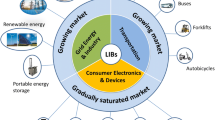Abstract
In applications of lithium ion batteries, it is a requisite to precisely appraise their fire and explosion hazards. In the current study, a fire calorimeter is utilized to test the combustion performance of two commercial 18650 lithium ion batteries (LiCoO2 and LiFePO4) at different state of charge (SOC). Characteristics on thermal hazards of lithium ion batteries including surface temperature, time to ejection, mass loss, and heat release rate (HRR) are measured and evaluated. In case of thermal runaway, all the lithium ion batteries will rupture the can and catch fire even explode automatically. The solid electrolyte interface layer decomposition and the polymer separator shrinking are direct causes of the lithium ion battery fire. The experimental results show that the HRR and total heat generally rise as the SOC increases, whereas the time to first ejection and the time gap between first and second ejection decrease. LiCoO2 18650 battery shows higher explosion risk than LiFePO4 18650, as the former has released much more oxygen. The experimental combustion heats calculated and modified in the oxygen consumption method reveal that the internally generated oxygen have significant effect on the estimate of the heat, where the largest modified rate is 29.9 for 100 % SOC LiCoO2 18650 battery. The results can provide scientific basis for fire protection during the storage and distribution of lithium ion batteries.






Similar content being viewed by others
References
Ritchie A, Howard W. Recent developments and likely advances in lithium-ion batteries. J Power Sources. 2006;162(2):809–12.
Fergus JW. Recent developments in cathode materials for lithium ion batteries. J Power Sources. 2010;195(4):939–54.
Farrington MD. Safety of lithium batteries in transportation. J Power Sources. 2001;96(1):260–5.
Wang Q, Ping P, Zhao X, Chu G, Sun J, Chen C. Thermal runaway caused fire and explosion of lithium ion battery. J Power Sources. 2012;208:210–24.
Roth EP, Doughty DH. Thermal abuse performance of high-power 18650 Li-ion cells. J Power Sources. 2004;128(2):308–18.
Aurbach D, Teller H, Koltypin M, Levi E. On the behavior of different types of graphite anodes. J Power Sources. 2003;119:2–7.
Chen X, Usrey M, Peña-Hueso A, West R, Hamers RJ. Thermal and electrochemical stability of organosilicon electrolytes for lithium-ion batteries. J Power Sources. 2013;241:311–9.
Liu Y, Mi C, Yuan C, Zhang X. Improvement of electrochemical and thermal stability of LiFePO4 cathode modified by CeO2. J Electroanal Chem. 2009;628(1):73–80.
Venugopal G, Moore J, Howard J, Pendalwar S. Characterization of microporous separators for lithium-ion batteries. J Power Sources. 1999;77(1):34–41.
Duh YS, Kao CS, Ou WJ, Hsu JM. Thermal instabilities of organic carbonates with charged cathode materials in lithium-ion batteries. J Therm Anal Calorim. 2014;116(3):1105–10.
Weng Y, Xu S, Huang G, Jiang C. Synthesis and performance of Li[(Ni1/3Co1/3Mn1/3)1− xMgx]O2 prepared from spent lithium ion batteries. J Hazard Mater. 2013;246:163–72.
Wen CY, Jhu CY, Wang YW, Chiang CC, Shu CM. Thermal runaway features of 18650 lithium-ion batteries for LiFePO4 cathode material by DSC and VSP2. J Therm Anal Calorim. 2012;109(3):1297–302.
Jhu CY, Wang YW, Wen CY, Chiang CC, Shu CM. Self-reactive rating of thermal runaway hazards on 18650 lithium-ion batteries. J Therm Anal Calorim. 2011;106(1):159–63.
Ribière P, Grugeon S, Morcrette M, Boyanov S, Laruelle S, Marlair G. Investigation on the fire-induced hazards of Li-ion battery cells by fire calorimetry. Energy Environ Sci. 2012;5(1):5271–80.
Thornton WM. The relation of oxygen to the heat of combustion of organic compounds. The London, Edinburgh Dublin Philos Mag J Sci. 1917;33(194):196–203.
Janssens ML. Measuring rate of heat release by oxygen consumption. Fire Technol. 1991;27(3):234–49.
Huggett C. Estimation of rate of heat release by means of oxygen consumption measurements. Fire Mater. 1980;4(2):61–5.
Wang Q, Sun J, Yao X, Chen C. Thermal behavior of lithiated graphite with electrolyte in lithium-ion batteries. J Electrochem Soc. 2006;153(2):A329–33.
Lu TY, Chiang CC, Wu SH, Chen KC, Lin SJ, Wen CY, Shu CM. Thermal hazard evaluations of 18650 lithium-ion batteries by an adiabatic calorimeter. J Therm Anal Calorim. 2013;114(3):1083–8.
Jiang J, Dahn JR. ARC studies of the thermal stability of three different cathode materials: LiCoO2; Li[Ni0.1Co0.8Mn0.1]O2; and LiFePO4, in LiPF6 and LiBoB EC/DEC electrolytes. Electrochem Commun. 2004;6(1):39–43.
MacNeil DD, Dahn JR. The reaction of charged cathodes with nonaqueous solvents and electrolytes: I. Li0. 5CoO2. J Electrochem Soc. 2001;148(11):A1205–10.
Joachin H, Kaun TD, Zaghib K, Prakash J. Electrochemical and thermal studies of carbon-coated LiFePO4 cathode. J Electrochem Soc. 2009;156(6):A401–6.
Kim J, Park KY, Park I, Yoo JK, Hong J, Kang K. Thermal stability of Fe–Mn binary olivine cathodes for Li rechargeable batteries. J Mater Chem. 2012;22:11964–70.
Chen M, He Y, Zhou D, Richard Y, Wang J. Experimental study on the combustion characteristics of primary lithium batteries fire. Fire Technol. 2014;. doi:10.1007/s10694-014-0450-1.
Acknowledgements
This research was supported by the National Natural Science Foundation of China (No. 51376172) and a Grant from the Research Grants Council of the Hong Kong Special Administrative Region (No. CityU 11215314).
Author information
Authors and Affiliations
Corresponding author
Rights and permissions
About this article
Cite this article
Chen, M., Zhou, D., Chen, X. et al. Investigation on the thermal hazards of 18650 lithium ion batteries by fire calorimeter. J Therm Anal Calorim 122, 755–763 (2015). https://doi.org/10.1007/s10973-015-4751-5
Received:
Accepted:
Published:
Issue Date:
DOI: https://doi.org/10.1007/s10973-015-4751-5




